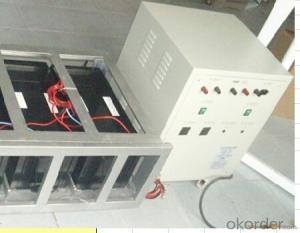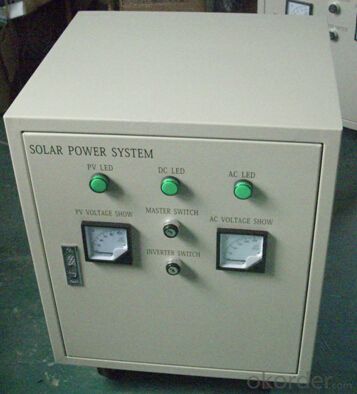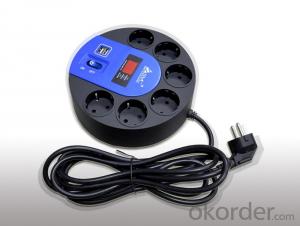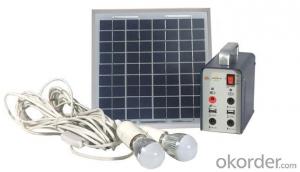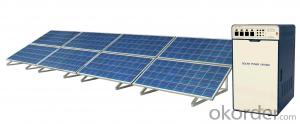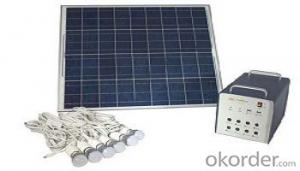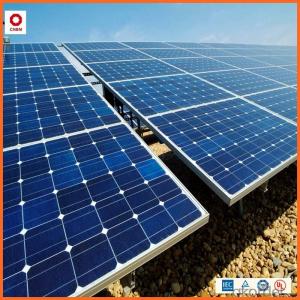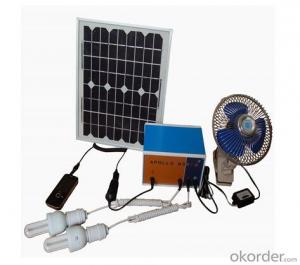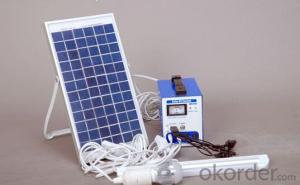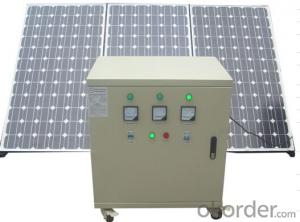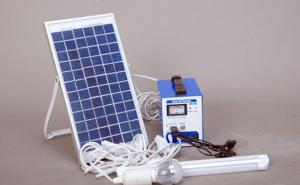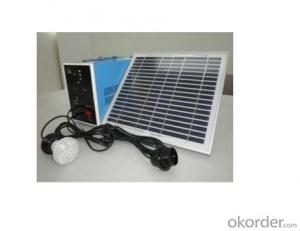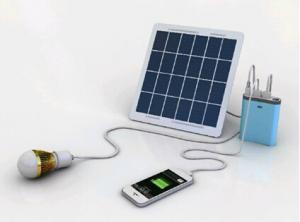CNBM Solar Home System Roof System Capacity-3000W - Solar Energy Systems NY
- Loading Port:
- Shanghai
- Payment Terms:
- TT or LC
- Min Order Qty:
- 5 pc
- Supply Capability:
- 30000 pc/month
OKorder Service Pledge
OKorder Financial Service
You Might Also Like
Introduction of Solar Home System
Solar Home System is composed by Solar Panels, Inverters, Charger Controller, Battery, Cable, Mounting Bracket, which is applied to produce electricity for home use.
Solar Home System is quite suitable product in urban area and the place which is short of electricity. Our Small Solar Home System own great benifits compare with other kind electricity resources:
Electricity generating cost of Solar Home System is much cheaper than diesel engine. Beside low electricity making cost, solar system products also have the features of noiseless, clean energy, environmentally friendly and can access to many different electric appliance.
Picture of Our Factory

Working Principle of Solar Home System
The stand alone Solar Home System is an off-grid solar system which uses batteries to store the solar energy. Stand alone solar system solutions design for those who are not able or willing to connect to electricity grid.
However, our on-grid solar home system can be connected to the grid for utilization of grid electricity power. Our solar system can add relative equipment as our customer’s requirement which have the function of switching to city electricity automatically. The solar system can use battery power in priority, if sunshine is not so good or loads consumption is too high which cause battery power insufficient. Then system can switch automatically to grid power supply. Meanwhile, the system can charge the batteries with grid power until batteries are fully charged. Then the solar system will switch back to battery power supply.
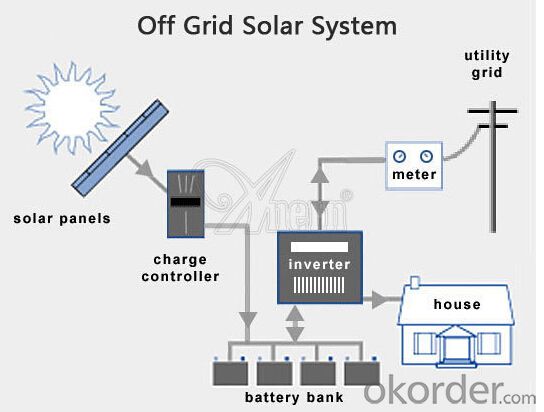
Product Details of Solar Home System
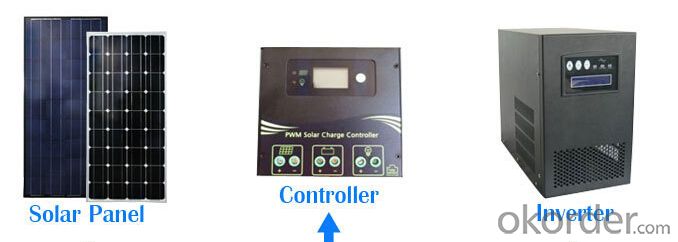
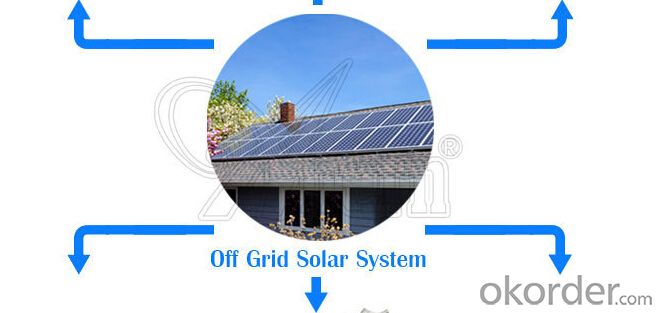

Specification of Solar Home System
Technical data: | ||||||||
Inverter | Rated load power | 3000W | ||||||
Output wave | Pure sine wave | |||||||
Input voltage | 48V | |||||||
Output voltage | DC:12V | |||||||
Output frequency | 50HZ/60HZ | |||||||
Precision of output frequency | ±6% | |||||||
Solar panel | Pmax | 250W*12PCS | ||||||
Vmp | 36V*2*6 | |||||||
Imp | 7A*6 | |||||||
Charger controller | Charger voltage & current | 48V/30A*3PCS | ||||||
Battery | Capacity | 12V/150AH*8PCS | ||||||
support | aluminium | 2PCS/SET*6 | ||||||
Power box | Spray paint iron box,with input,output, ammeter,voltmeter,master switch and so on. | |||||||
Package data: | ||||||||
Part | Size (L*W*H mm) | Weight (kg) | 20' (pcs) | 40' (pcs) | ||||
Power box | 580*520*540 | 70 | 48Sets | 240Sets | ||||
Solar panel | 1970*1010*110*(6ctns) | 180 | ||||||
Battery | 1100*520*650 | 600 | ||||||
Loading electrical equipment(For consulting) | ||||||||
Name of Load | Power(W) | Quantity | Working Time per Day (H) | Working Days | ||||
Color TV | 65W | 2 | 6 | 3 days | ||||
Satellite TV Receivers | 25W | 2 | 6 | 3 days | ||||
lamp | 11W | 8 | 8 | 3 days | ||||
Computer | 150 W | 2 | 6 | 3 days | ||||
FAN | 60W | 4 | 6 | 3 days | ||||
Other | 1000W | 1 | 6 | 3 days | ||||
Terms and Conditions
1. Trade terms: FOB Shanghai
2. Payment terms: 30% T/T, balanced before shipment/ LC at sight before shipment. Actual Terms can be negotiated for big order.
3. Package: Exported standard package suitable for tough handling and sea transport.
4. Delivery: Goods to be ready within 10~30 days depending on order quantity.
5. Warranty: 10 years for solar panel, 2 years for controller/inverter/battery.
- Q: What is a solar inverter and why is it necessary?
- A solar inverter is an electronic device that converts the direct current (DC) electricity generated by solar panels into alternating current (AC) electricity, which is used to power our homes and businesses. It is necessary because most of our electrical appliances and grid systems operate on AC power, while solar panels produce DC power. The solar inverter bridges this gap by ensuring the compatibility and usability of the solar energy, enabling us to utilize the power generated by solar panels efficiently and effectively.
- Q: What is the difference between a grid-tied and off-grid solar energy system?
- A grid-tied solar energy system connects to the local electricity grid, while an off-grid solar energy system operates independently and is not connected to the grid. In a grid-tied system, electricity is generated from the sun by solar panels and converted into usable AC power through an inverter. This power is used by the household or business where the system is installed. If the solar panels produce more electricity than is consumed, the excess power is sent back to the grid, resulting in possible credit or payment from the utility company. When the solar panels do not generate enough power, electricity is drawn from the grid, ensuring a continuous and reliable power supply with the grid serving as a backup. On the other hand, an off-grid solar energy system is designed to operate independently from the grid. It typically includes a battery bank to store surplus electricity generated by the solar panels. This stored power can be used when the panels do not produce enough. An inverter is also required to convert the solar panels' DC power into usable AC power. Off-grid systems are commonly used in remote areas where connecting to the grid is expensive or impractical. The main difference between the two systems lies in their level of independence and connection to the grid. Grid-tied systems offer the advantage of selling excess electricity back to the utility company, potentially saving costs or generating revenue. They also provide a reliable power supply by using grid power when solar production is low. On the other hand, off-grid systems provide complete energy independence and do not rely on the grid. However, they require careful planning and sizing to ensure sufficient power availability at all times since there is no grid backup. Additionally, off-grid systems often necessitate more complex equipment, such as batteries, for storing and managing electricity.
- Q: What is the role of maximum power point tracking (MPPT) in a solar energy system?
- The role of maximum power point tracking (MPPT) in a solar energy system is to maximize the efficiency and output of the system by continuously adjusting the operating point of the solar panels to ensure they are operating at their maximum power point. This is important because the power output of solar panels is highly dependent on environmental factors such as temperature and sunlight intensity. MPPT algorithms track these variations and optimize the power output by adjusting the voltage and current to match the maximum power point. By doing so, MPPT increases the overall energy generation and improves the performance of the solar energy system.
- Q: What is the future of solar energy technology?
- The future of solar energy technology is promising and holds immense potential. With ongoing advancements in solar panel efficiency, energy storage, and grid integration, solar power is poised to become a major contributor to global energy production. As the cost of solar installations continues to decline, coupled with increased government support and public awareness of the environmental benefits, solar energy is expected to witness exponential growth in the coming years. Additionally, emerging technologies like perovskite solar cells and solar-powered water splitting hold the promise of further enhancing solar energy efficiency and expanding its applications. Ultimately, solar energy technology is likely to play a crucial role in transitioning towards a sustainable and renewable energy future.
- Q: Can a solar energy system be installed in areas prone to hailstorms?
- Yes, solar energy systems can be installed in areas prone to hailstorms. However, it is essential to consider certain factors to ensure their durability and resilience against hail damage. This includes using high-quality materials, such as tempered glass for solar panels, and proper installation techniques. Additionally, some solar panels are specifically designed to withstand hail and extreme weather conditions, providing further protection.
- Q: Can solar energy systems be used for powering telecommunications towers or antennas?
- Yes, solar energy systems can definitely be used for powering telecommunications towers or antennas. Solar power is a sustainable and reliable source of energy that can be harnessed to provide electricity for various applications, including powering telecommunications infrastructure. Telecommunications towers and antennas require a constant and uninterrupted supply of electricity to function effectively. Traditional methods of powering these towers, such as diesel generators, are not only expensive but also contribute to pollution and carbon emissions. Solar energy systems offer a cleaner and more cost-effective alternative. Solar panels, installed on or around the telecommunications tower, capture sunlight and convert it into electricity through photovoltaic cells. This electricity can either be used directly to power the tower's equipment or stored in batteries for later use during periods of low sunlight. By utilizing solar energy, telecommunication companies can reduce their dependence on fossil fuels and lower their operational costs. Moreover, solar energy systems can be installed in remote locations where it is often challenging to access the grid or establish a reliable power supply. In such cases, solar power can provide a viable solution, allowing telecommunication companies to extend their coverage and connectivity to underserved areas. In conclusion, solar energy systems are an excellent choice for powering telecommunications towers or antennas. They offer a sustainable and cost-effective solution while reducing environmental impact. With advancements in solar technology, the efficiency and reliability of solar power systems continue to improve, making them a viable option for the telecommunications industry.
- Q: What is the role of surge protectors in a solar energy system?
- Surge protectors play a vital role in safeguarding solar energy systems against power surges and voltage spikes. These systems generate electricity using photovoltaic panels that convert sunlight into usable energy. However, sudden voltage surges caused by lightning strikes, grid fluctuations, or equipment malfunctions can potentially damage the solar panels, inverters, and other components. To protect against these risks, surge protectors act as a protective barrier. They divert excess voltage away from the system, safeguarding sensitive equipment from potential damage. By monitoring the electrical current and automatically redirecting any excess voltage to a grounding wire, surge protectors help maintain a stable flow of electricity, ensuring the system's longevity and performance. In addition to preventing power surges, surge protectors also reduce the risk of electrical fires that can result from overvoltage situations. By preventing excessive voltage from reaching critical components, surge protectors significantly lower the chances of electrical failures and potential fire hazards. Furthermore, surge protectors enhance the overall safety of the solar energy system, providing protection for homeowners and professionals working on the system. They create a reliable barrier that diverts high voltages away from the system and safely grounds them, preventing electrical shocks. In conclusion, surge protectors are an essential component in solar energy systems. They protect against power surges, voltage spikes, and potential electrical hazards, contributing to the system's integrity, safety, optimal performance, and longevity.
- Q: How do I maintain a solar energy system?
- Maintaining a solar energy system is relatively easy and involves regular inspections and basic upkeep. Here are some essential steps to guarantee the efficient operation and long lifespan of your solar energy system: 1. Regularly clean the solar panels to keep them free from dirt, dust, and debris. You can use a soft cloth or sponge with mild soapy water to gently clean the surface. Avoid using abrasive materials or high-pressure water, as they can cause damage to the panels. 2. Conduct regular checks for shading by inspecting the area surrounding your solar panels. Make sure there are no obstructions that may cause shading. Shading can significantly decrease the system's efficiency, so trim any overhanging branches or remove any objects blocking the sunlight. 3. Keep a close watch on the system's performance to detect any potential issues. If you notice a sudden decrease in energy production, it may indicate a problem with the panels or the inverter. There are monitoring systems available that can provide real-time data on your system's performance. 4. Periodically inspect the wiring and electrical connections to ensure they are secure and undamaged. Loose connections or corroded wires can result in power loss or system failure. 5. Regularly test the inverter, which is a vital component that converts the DC electricity generated by the solar panels into AC electricity for use in your home. Ensure that it is functioning correctly and efficiently. 6. It is recommended to have a professional inspection every few years, in addition to regular maintenance performed by the system owner. Professionals can identify potential issues and carry out more comprehensive maintenance tasks that require specialized expertise. 7. Stay informed by keeping up with the manufacturer's maintenance recommendations and any specific requirements for your particular solar energy system. They may provide guidelines on cleaning, maintenance schedules, or software updates. By adhering to these maintenance practices, you can ensure that your solar energy system operates optimally and continues to generate clean and renewable energy for many years to come.
- Q: Can a solar energy system be used in conjunction with other renewable energy sources?
- Yes, a solar energy system can definitely be used in conjunction with other renewable energy sources. In fact, combining different renewable energy sources like solar, wind, hydro, or geothermal can provide a more reliable and efficient energy system. This approach, known as hybrid renewable energy systems, allows for a diversified and balanced energy supply, ensuring continuous power generation even when one source is not available or producing at full capacity.
- Q: What is the role of microinverters in solar energy systems?
- Microinverters play a crucial role in solar energy systems as they convert the direct current (DC) generated by each individual solar panel into alternating current (AC) that can be used to power appliances and be connected to the electrical grid. By allowing each panel to operate independently, microinverters optimize the overall performance of the system, increase energy production, and provide greater flexibility in system design and monitoring.
Send your message to us
CNBM Solar Home System Roof System Capacity-3000W - Solar Energy Systems NY
- Loading Port:
- Shanghai
- Payment Terms:
- TT or LC
- Min Order Qty:
- 5 pc
- Supply Capability:
- 30000 pc/month
OKorder Service Pledge
OKorder Financial Service
Similar products
Hot products
Hot Searches
Related keywords
